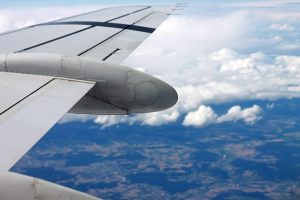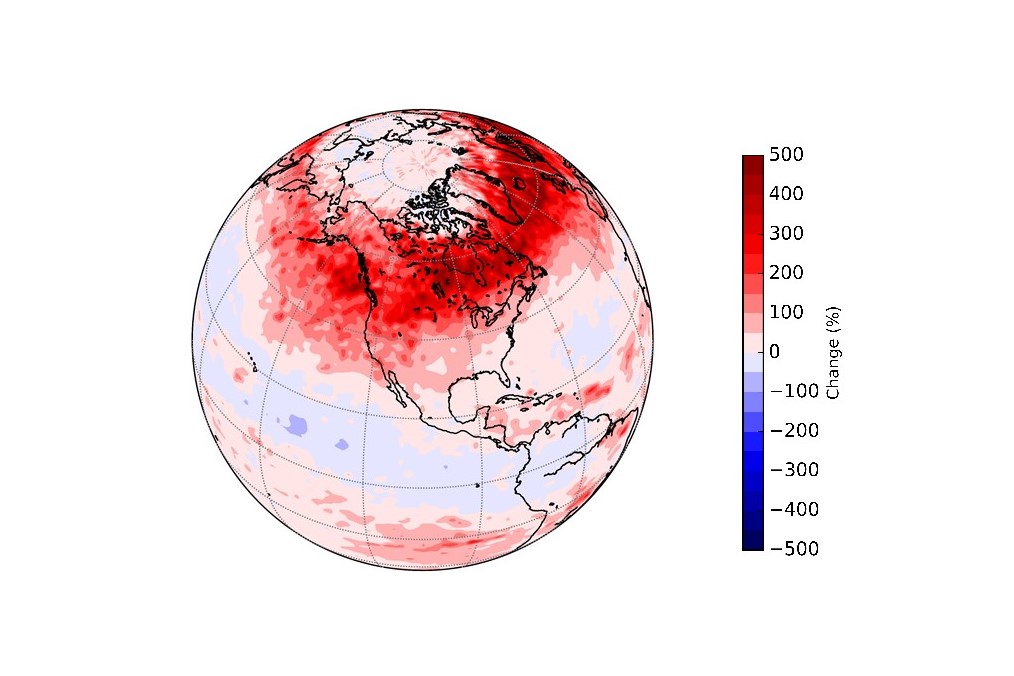4 October 2017
WASHINGTON D.C. — Flights all around the world could be encountering lots more turbulence in the future, according to the first ever global projections of in-flight bumpiness.

An aerial view on board a flying airplane. New research predicts that climate change will increase the risk of turbulence by 2050-2080
Credit: pexels.com; public domain
A new study published online in Geophysical Research Letters, a journal of the American Geophysical Union, has calculated that climate change will significantly increase the amount of severe turbulence worldwide by 2050–2080. Severe turbulence involves forces stronger than gravity, and is strong enough to throw people and luggage around an aircraft cabin.
Flights to the most popular international destinations are projected to experience the largest increases, with severe turbulence at a typical cruising altitude of 39,000 feet becoming up to two or three times as common throughout the year over the North Atlantic (180 percent more common), Europe (160 percent more common), North America (110 percent more common), the North Pacific (90 percent more common), and Asia (60 percent more common).
“Air turbulence is increasing across the globe, in all seasons, and at multiple cruising altitudes. This problem is only going to worsen as the climate continues to change,” said Paul Williams, Professor of Atmospheric Science at the University of Reading in the United Kingdom and lead author of the new study. “Our study highlights the need to develop improved turbulence forecasts, which could reduce the risk of injuries to passengers and lower the cost of turbulence to airlines.”
The study also makes the first ever turbulence projections for the Southern Hemisphere and the tropical regions of the planet. The amount of airspace containing severe turbulence is calculated to increase over South America (60 percent increase), Australia (50 percent increase), and Africa (50 percent increase).

A map of the percentage change in the amount of moderate turbulence by the period 2050-2080 at 39,000 feet in altitude in Autumn (September, October, November) in North America
Credit: Paul Williams.
“While turbulence does not usually pose a major danger to flights, it is responsible for hundreds of passenger injuries every year,” said Luke Storer, a researcher at the University of Reading and co-author of the new study. “It is also by far the most common cause of serious injuries to flight attendants. Turbulence is thought to cost United States air carriers up to $200 million annually.”
The new research analyzes supercomputer simulations of the future atmosphere with a focus on clear-air turbulence, which is particularly hazardous because it is invisible. The expected turbulence increases are a consequence of global temperature changes, which are strengthening wind instabilities at high altitudes in the jet streams and making pockets of rough air stronger and more frequent.
“The study is another example of how the impacts of climate change can be felt through the circulation of the atmosphere, not just through increases in surface temperature itself,” said Manoj Joshi, a Senior Lecturer in Climate Dynamics at the University of East Anglia in the United Kingdom and co-author of the new study.
###
The American Geophysical Union is dedicated to advancing the Earth and space sciences for the benefit of humanity through its scholarly publications, conferences, and outreach programs. AGU is a not-for-profit, professional, scientific organization representing 60,000 members in 137 countries. Join the conversation on Facebook, Twitter, YouTube, and our other social media channels.
Notes for Journalists
This research article is open access for 30 days. A PDF copy of the article can be downloaded at the following link:
http://onlinelibrary.wiley.com/doi/10.1002/2017GL074618/pdf.
Journalists and PIOs may also order a copy of the final paper by emailing a request to Nanci Bompey at [email protected]. Please provide your name, the name of your publication, and your phone number.
Neither the paper nor this press release is under embargo.
“Global Response of Clear-Air Turbulence to Climate Change”
Authors:
Luke N. Storer: Department of Meteorology, University of Reading, Reading, United Kingdom;
Paul D. Williams: Department of Meteorology, University of Reading, Reading, United Kingdom;
Manoj M. Joshi: Climatic Research Unit, School of Environmental Sciences, University of East Anglia, Norwich, United Kingdom.
Contact information for the authors:
Paul D. Williams: [email protected], +44 (0) 118 378 8424
Nanci Bompey
+1 (202) 777-7524
[email protected]
University of Reading Press Contact:
Pete Bryant
+44 (0) 118 378 5757
[email protected]